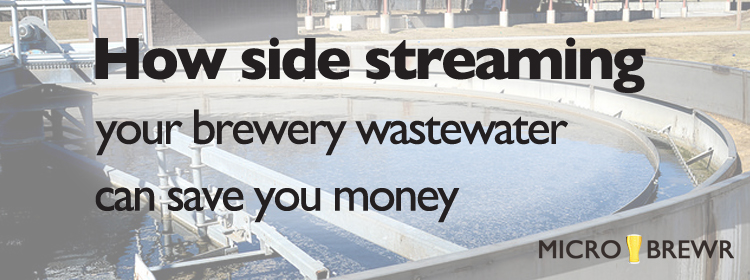How side streaming your brewery wastewater can save you money
For every gallon of beer made, it takes 7 gallons of water. Hopefully you thought about your brewery wastewater management before you built your brewery. Even if you’ve been producing beer for years, there are things you can do to reduce your load on the municipal wastewater treatment facility and potentially reduce your sewage bill.
John Mercer has more than 15 years of wastewater experience in breweries and laboratories. His company, Brewery Wastewater Design in Montrose, Colorado, specializes in designing wastewater systems for breweries of all sizes.
John was our guest on MicroBrewr Podcast episode 033. He taught us all about wastewater treatment for a craft brewery. I was fascinated by the concept of side-streaming to possibly cut costs from the sewage treatment plant. So I asked John to write a blog about it.
Check out more free resources about brewery wastewater management on the Brewery Wastewater Design website.
How side streaming your brewery wastewater can save you money
What is side stream?
Side-streaming is collecting high strength, concentrated wastes at the source—before it hits the floor, and setting it aside for disposal. Sources of this high-strength wastewater include fermenter bottoms, spent yeast, returned beer in kegs, fermenter blow off, beer in hoses or pipes at the beginning or end of a packaging run; but the primary source is the brewhouse.
Lauter tun rinsings, hop back rinsings, kettle residues, and trub. All of this material is very high in BOD (biochemical oxygen demand) and TSS (total suspended solids) and are easy targets to separate if you need or want to lower the BOD and TSS of your brewery’s wastewater. BOD can’t just be filtered from your wastewater.
How to collect side stream at a brewery
My favorite method for collecting this side-stream material is via an equipment drain. Very similar to a floor drain, but there is no drain. Instead a pipe extends up through the floor about 6 inches. This prevents other material from entering the pipe. Specific high-strength materials are piped or hosed into the equipment drain. Everything else enters the normal floor-drain system.
If you’re following along, you will notice that this requires a separate set of drain lines under your slab. One set for floor drains, another set for side-stream drains. If you are building a new brewery or tearing up the slab in an existing building this is definitely the way to go.
Luckily you don’t need many of these side-stream equipment drains:
- 1 in the brewhouse area
- 1 to 2 in the cellar area
- 1 to 2 in the packaging areas.
You can still side stream if you can’t or don’t want to tear up your slab, it just gets a little trickier.
You will have to go overhead or along the walls with the piping, so you will need to pump the material. Lots of pumps. Double diaphragm pumps work fine, make sure it can handle solids and if it’s in the brewhouse, make sure it can handle high temperatures.
Now you need something to pump out of. An old 55-gallon drum with the top cut off works, but it will deform. Better is a ‘portable floor drain’ made of stainless steel that can be wheeled around. Something short with casters on it, so it can go under a whirlpool or lauter tun.
What to do with the side stream from your brewery
However you do it, collect this material and put it in a tank (outdoors, in back, it’ll stink), and spread it on pastures as fertilizer—or even feed it to animals. You could have one big tank or you could use old chemical totes (IBCs); doesn’t need to be fancy. It can go on the fields as is, solids and high temperature are OK.
If feeding it to animals, make sure you are not responsible for any misuse of this product by the hauler/farmer; it can cause bloat and drunkenness. Generally the fertilizer content of this material is lower than the cost of hauling, so you may have to pay for hauling. But if you have a fertilizer company nearby, they might pay you for it.
Of course, spent grain should be your first side stream. You might even decide to add your trub and spent yeast in here. Spent grain does have value as feed. At a minimum you can give it away in exchange for the farmer promptly hauling it away. Maybe you can get some free beef out of the deal. Larger breweries should be able to sell their spent grain.
The value of spent grain increases as moisture content decreases; 80% moisture is a great target.
How side streaming can help save you money
After side streaming, the remaining portion of your wastewater can be referred to as low-strength wastewater. This will be cleaning and CIP water in your cellar and brewhouse, as well as any packaging line wastewater, boiler blow-down, cooling tower blow-down, and general wash-down waters. The BOD of this low-strength wastewater is still high-strength compared to typical municipal wastewater, so side streaming doesn’t solve all of your problems, but it does help. BOD & TSS are what most municipalities look at then applying surcharges. Sanitary wastewater (toilets, sinks, kitchen) should not be included in the low-strength waste stream and should be piped directly to the sanitary sewer.
The best option for disposal of the low-strength wastewater is almost always to have someone else treat your wastewater for you—especially if they do it for free. Doing what you can to make the people at your municipality happy to treat your wastewater for you is a great deal.
Always ‘play nice’ with the regulators
My best piece of advice for any brewer may be to ‘play nice’ with the regulatory authorities you have to deal with. They may give you rules, laws, and limits to abide by, as well as charge fees—and you might not agree with them all. But smile, be courteous and professional, and try to see things from their perspective. Do not get into an adversarial relationship. They have lawyers on retainer and they probably know their laws better than you do.
All of this doesn’t mean don’t try to negotiate—just be professional. They can treat your wastewater cheaper than you can, plus they already have the rate-payer-funded equipment and staff. Just hope they have capacity.
Image showing Fulton Officials Discuss Improvements to Wastewater Treatment Plant by KOMUnews on flickr (CC BY 2.0) was modified from its orignal state.
Join the mail list
Don’t miss other great posts like this one.
Sign up for the email list: Sign me up!





At IBC Tote recylcing we actually deal with tons of breweries, but they are usually looking for “food grade ibc totes” for a side project. Although we do sometimes find some companies buying a lot of used ibc tanks for this very reason. If you can find cheap totes its very easy to deal with as long as the valves are working and the cap be placed on the tote after your done. The only downside to this is it’s against the epa to transport any second hand liquid. You would need to make sure the tote is RCRA empty meaning there is less than 3″of waste remaining within the tote. If you have any questions all the tote companies can you assist you on used totes or how to get rid of them.
Thanks for the tip, John.
I like what you said about side-streaming your wastewater to collect waste before it hits the floor. My sister wants to open a brewery in the coming years. I’ll share this information with her so that she can look into her options for wastewater design contractors who can help her with this.
Fantastic! And feel free to point her toward MicroBrewr for resources on how to start a brewery.